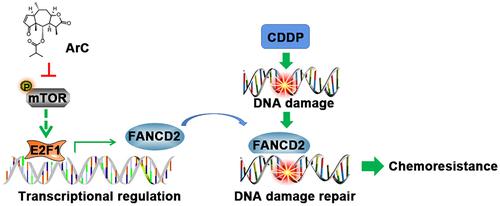当前位置:
X-MOL 学术
›
Br. J. Pharmacol.
›
论文详情
Our official English website, www.x-mol.net, welcomes your feedback! (Note: you will need to create a separate account there.)
Identification of arnicolide C as a novel chemosensitizer to suppress mTOR/E2F1/FANCD2 axis in non-small cell lung cancer
British Journal of Pharmacology ( IF 6.8 ) Pub Date : 2023-11-05 , DOI: 10.1111/bph.16281 Yu-Fei Chen 1, 2 , Yan-Chun Pang 1, 2 , Han-Chen Wang 1, 2 , Pei-En Wu 1, 2 , Zi-Jie Chen 1, 2 , Da Huang 1, 2 , Dong-Ling Peng 1, 2 , Yong-Ming Yan 3 , Changhui Liu 1, 2 , Li-Chuan Wu 4 , Xiang-Zhen Fan 5 , Yong-Xian Cheng 3 , Yong-Qiang Liu 1, 2, 6
British Journal of Pharmacology ( IF 6.8 ) Pub Date : 2023-11-05 , DOI: 10.1111/bph.16281 Yu-Fei Chen 1, 2 , Yan-Chun Pang 1, 2 , Han-Chen Wang 1, 2 , Pei-En Wu 1, 2 , Zi-Jie Chen 1, 2 , Da Huang 1, 2 , Dong-Ling Peng 1, 2 , Yong-Ming Yan 3 , Changhui Liu 1, 2 , Li-Chuan Wu 4 , Xiang-Zhen Fan 5 , Yong-Xian Cheng 3 , Yong-Qiang Liu 1, 2, 6
Affiliation

|
The mammalian target of rapamycin (mTOR) pathway plays critical roles in intrinsic chemoresistance by regulating Fanconi anaemia complementation group D2 (FANCD2) expression. However, the mechanisms by which mTOR regulates FANCD2 expression and related inhibitors are not clearly elucidated. Extracts of Centipeda minima (C. minima) showed promising chemosensitizing effects by inhibiting FANCD2 activity. Here, we have aimed to identify the bioactive chemosensitizer in C. minima extracts and elucidate its underlying mechanism.
中文翻译:

鉴定 Arnicolide C 作为抑制非小细胞肺癌 mTOR/E2F1/FANCD2 轴的新型化疗增敏剂
哺乳动物雷帕霉素靶点 (mTOR) 通路通过调节范可尼贫血补充组 D2 (FANCD2) 的表达,在内在化疗耐药性中发挥关键作用。然而,mTOR 调节 FANCD2 表达的机制以及相关抑制剂尚不清楚。小蜈蚣( C. minima )提取物通过抑制 FANCD2 活性显示出有希望的化学增敏作用。在这里,我们的目的是鉴定极小念珠菌提取物中的生物活性化学增敏剂并阐明其潜在机制。
更新日期:2023-11-05
中文翻译:

鉴定 Arnicolide C 作为抑制非小细胞肺癌 mTOR/E2F1/FANCD2 轴的新型化疗增敏剂
哺乳动物雷帕霉素靶点 (mTOR) 通路通过调节范可尼贫血补充组 D2 (FANCD2) 的表达,在内在化疗耐药性中发挥关键作用。然而,mTOR 调节 FANCD2 表达的机制以及相关抑制剂尚不清楚。小蜈蚣( C. minima )提取物通过抑制 FANCD2 活性显示出有希望的化学增敏作用。在这里,我们的目的是鉴定极小念珠菌提取物中的生物活性化学增敏剂并阐明其潜在机制。






































 京公网安备 11010802027423号
京公网安备 11010802027423号